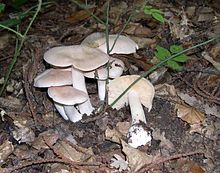Entoloma
| Entoloma | |
|---|---|
 |
|
|
E. sinuatum Piacenza's Appennino, Italy |
|
| Scientific classification | |
| Kingdom: | Fungi |
| Division: | Basidiomycota |
| Class: | Agaricomycetes |
| Subclass: | Hymenomycetes |
| Order: | Agaricales |
| Family: | Entolomataceae |
| Genus: |
Entoloma (Fr.) P.Kumm. (1871) |
| Type species | |
|
Entoloma sinuatum (Bull.) P.Kumm. (1871) |
|
| Species | |
|
|
|
Entoloma is a large genus of terrestrial pink-gilled mushrooms, with about 1000 species. They have a drab appearance, pink gills which are attached to the stem, a smooth thick cap, and angular spores. Most entolomas are saprobic. The best-known member of is the livid agaric (Entoloma sinuatum), responsible for a number of poisonings over the years in Europe and North America, and Entoloma rhodopolium in Japan. Some southern hemisphere species such as Entoloma rodwayi and Entoloma viridomarginatum from Australia, and Entoloma hochstetteri from New Zealand, are very colourful, with caps of unusual shades of green and blue-green. Most entolomas are dull shades of olive, brown, or grey and some are mycorrhizal.
The part means "within, inside". The part "loma" is a noun-forming element derived from Greek , "fringe, hem" and used in the botanical taxonomy for naming plants distinguished by having a fringe or hem or particular kind described by the initial part of the word. In the case of Entoloma, the term refers to mushrooms with the hem turned inside.
The name is derived from the Greek entos (ἐντός) meaning inner and lóma (λῶμα) meaning fringe from the in-rolled margin. The Swedish mycologist Elias Magnus Fries classified all pink-spored gilled fungi in a series Hyporhodius within his large genus Agaricus, subdividing into five tribes based on cap shape, gills and size in 1821. He later refined this in 1838, placing those with universal veils into tribe Volvaria, those with free gills and a discrete stipe into tribe Pluteus, those with a Tricholoma-like shape into tribe Entoloma, and those with a depressed cap and decurrent gills into tribe Clitopilus. The small tribe Leptonia had convex fleshy membranaceous caps, the tribe Nolanea, were slender fungi with bell-shaped caps and hollow stems, and lastly tribe Eccilia had umblicilate caps and adnate gills. Paul Kummer raised Entoloma, Nolanea, Leptonia and Eccilia to genus-level in 1871, though Lucien Quélet created a new genus Rhodophyllus uniting all those fungi with pinkish-red adnate or sinuate gills and angular spores, similar in scope to the original Hyporhodius. The two classifications coexisted until recently, with those taxonomists favoring a broader genus concept following Quélet, and the others Kummer. French mycologist Henri Romagnesi took up study of the genus in what was to last over forty years, describing new species and creating a new infrageneric classification making it one of the most studied and best known agaric genera to date. Over time, more authors and texts have followed Kummer.
...
Wikipedia
